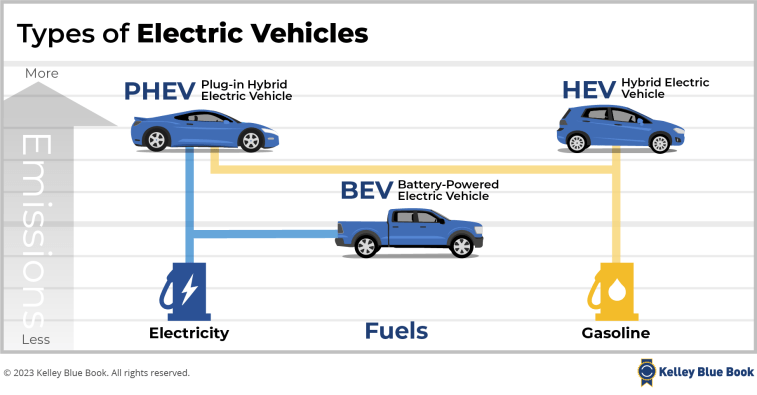Why a Plug-in Hybrid Might Be the Right Electric Car for You
By Andrew Ganz 03/29/2022 3:54pm

If higher gas prices or just the desire to drive more miles while spending less money on fuel seems appealing, you might be considering a plug-in hybrid electric vehicle for your next purchase.
We get it. Electric cars do not appeal to everyone. Yes, there’s the lure of tailpipe-free emissions. And the most advanced electric cars on the market today can drive distances of about 400 miles between charges. But they still require charging, which takes quite a bit longer than a fill-up at a gas pump.
A plug-in hybrid electric vehicle, or PHEV, strikes an ideal balance between eco-friendly motoring and go-anywhere flexibility for drivers. It also helps you extend your mileage between trips to the gas station. Most commuters can drive to and from work on electric power alone, while the gas engine stands in reserve waiting for longer road trips.
We’ll tell you about how plug-in hybrids and electric cars differ, plus the advantages and what you can expect from a PHEV.
RELATED: How Much Does it Cost to Charge an Electric Car?
How Plug-in Hybrids and Electric Cars Differ

Think of a PHEV as a vehicle that splits the difference between a conventional gasoline car and a fully electric vehicle.
A PHEV can handle drives typically between 12 miles and 30 miles using electric power alone. Some of the latest models will go even farther on battery power alone. A gasoline engine fires up and works with the electric motor and battery pack to provide relatively low fuel consumption.
Though most PHEVs allow drivers to decide when they want to tap that electric power reserve, the transition to gasoline power is nearly seamless. You may notice an additional underhood thrum from the gas engine, but that’s it.
Even if your round-trip commute is closer to 50 miles, fear not. PHEV cars can typically charge up within several hours.
PHEVs essentially start as gas-fueled cars. Pop the hood, and you’ll find a gasoline engine with an electric motor typically nestled next to it. Hidden under the back seat or somewhere in the trunk/cargo area, you’ll find a larger battery pack than the shoebox-size one under the hood but not nearly as big as what powers a fully electric car.
You’ll find two small doors outside the vehicle. One for fuel and one for electric charging.
Most of today’s PHEVs look just like their conventional gas-fueled counterparts, aside from that extra charging door.
By contrast, an electric car discards the gasoline engine entirely. So you need to plan trips more carefully around your vehicle’s charging needs.
Still, both electric vehicles and PHEVs need time to charge on the Level 1 or 2 chargers most owners will put in their garages or use when out and about.
READ MORE: Electric Cars 101: What You Need to Know
Advantages of Plug-in Hybrids
For drivers, the most significant advantage of a PHEV is going anywhere with no need to stop for time-consuming charges.
Once the battery depletes, a PHEV drives much like a conventional hybrid car. Its electric motor provides some assistance to the gas engine, saving fuel compared to a gas-only vehicle. Additionally, certain driving situations can provide charge to the battery, though not enough to add more than a mile or so of electric driving at a time.
Only the most discerning eyes will notice a difference between a PHEV and an equivalent gas or hybrid vehicle. A PHEV is perfect for eco-friendly drivers who still want the get-up-and-go of gas for long trips.
One big plus of plug-in hybrids is the federal tax incentives of up to $7,500 on certain new vehicle purchases (it doesn’t apply to leased vehicles). While you’ll need to include the incentive at tax time, it helps defray the higher cost of the PHEV. The incentives restrict qualifying vehicles to low-emissions trucks, SUVs, and vans with manufacturer’s suggested retail prices (MSRPs) of up to $80,000 and cars up to $55,000.
Brands That Offer Plug-in Hybrids
PHEV offerings fall into two major categories, at least currently. What works best for you may come down to how much you want to spend.
Luxury car automakers such as BMW, Mercedes-Benz, Audi, and Volvo offer PHEV versions of several models. Volvo’s T8 powertrain — found in several models, including sedans and SUVs — is perhaps the most common among premium brands.
If you don’t want to spend $50,000 or more on a new PHEV, don’t despair. Mainstream automakers offer a variety of options.
Toyota calls its PHEVs “Prime”, and the automaker currently offers Prime versions of its RAV4 SUV and its Prius hatchback. With 42 miles of electric range and standard all-wheel drive, it’s no wonder that consumers want the RAV4 Prime, which is in high demand.
The Honda Clarity comes in either hybrid or PHEV forms as well. Ford offers a plug-in version of its Escape SUV.
Adventurous types can look to the Jeep Wrangler 4xe, which boasts about 22 miles of electric range plus tremendous off-road capability.
